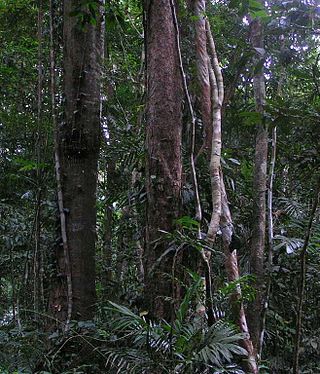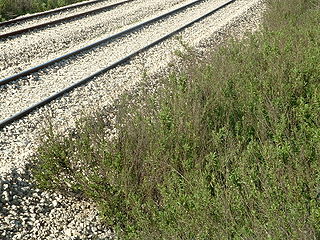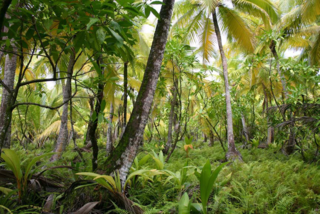
In ecology, a niche is the match of a species to a specific environmental condition. It describes how an organism or population responds to the distribution of resources and competitors and how it in turn alters those same factors. "The type and number of variables comprising the dimensions of an environmental niche vary from one species to another [and] the relative importance of particular environmental variables for a species may vary according to the geographic and biotic contexts".
This glossary of ecology is a list of definitions of terms and concepts in ecology and related fields. For more specific definitions from other glossaries related to ecology, see Glossary of biology, Glossary of evolutionary biology, and Glossary of environmental science.

Population ecology is a sub-field of ecology that deals with the dynamics of species populations and how these populations interact with the environment, such as birth and death rates, and by immigration and emigration.

The intermediate disturbance hypothesis (IDH) suggests that local species diversity is maximized when ecological disturbance is neither too rare nor too frequent. At low levels of disturbance, more competitive organisms will push subordinate species to extinction and dominate the ecosystem. At high levels of disturbance, due to frequent forest fires or human impacts like deforestation, all species are at risk of going extinct. According to IDH theory, at intermediate levels of disturbance, diversity is thus maximized because species that thrive at both early and late successional stages can coexist. IDH is a nonequilibrium model used to describe the relationship between disturbance and species diversity. IDH is based on the following premises: First, ecological disturbances have major effects on species richness within the area of disturbance. Second, interspecific competition results in one species driving a competitor to extinction and becoming dominant in the ecosystem. Third, moderate ecological scale disturbances prevent interspecific competition.

Forest ecology is the scientific study of the interrelated patterns, processes, flora, fauna and ecosystems in forests. The management of forests is known as forestry, silviculture, and forest management. A forest ecosystem is a natural woodland unit consisting of all plants, animals, and micro-organisms in that area functioning together with all of the non-living physical (abiotic) factors of the environment.

Intraspecific competition is an interaction in population ecology, whereby members of the same species compete for limited resources. This leads to a reduction in fitness for both individuals, but the more fit individual survives and is able to reproduce. By contrast, interspecific competition occurs when members of different species compete for a shared resource. Members of the same species have rather similar requirements for resources, whereas different species have a smaller contested resource overlap, resulting in intraspecific competition generally being a stronger force than interspecific competition.
Life history theory (LHT) is an analytical framework designed to study the diversity of life history strategies used by different organisms throughout the world, as well as the causes and results of the variation in their life cycles. It is a theory of biological evolution that seeks to explain aspects of organisms' anatomy and behavior by reference to the way that their life histories—including their reproductive development and behaviors, post-reproductive behaviors, and lifespan —have been shaped by natural selection. A life history strategy is the "age- and stage-specific patterns" and timing of events that make up an organism's life, such as birth, weaning, maturation, death, etc. These events, notably juvenile development, age of sexual maturity, first reproduction, number of offspring and level of parental investment, senescence and death, depend on the physical and ecological environment of the organism.

A ruderal species is a plant species that is first to colonize disturbed lands. The disturbance may be natural – for example, wildfires or avalanches – or the consequences of human activities, such as construction or agriculture.

Competition is an interaction between organisms or species in which both require a resource that is in limited supply. Competition lowers the fitness of both organisms involved since the presence of one of the organisms always reduces the amount of the resource available to the other.
Sand dune ecology describes the biological and physico-chemical interactions that are a characteristic of sand dunes.

An ephemeral plant is a plant with a very short life cycle or very short period of active growth, often one that grows only during brief periods when conditions are favorable. Several types of ephemeral plants exist. The first, spring ephemeral, refers to perennial plants that emerge quickly in the spring and die back to their underground parts after a short growth and reproduction phase. Desert ephemerals are plants which are adapted to take advantage of the short wet periods in arid climates. Mud-flat ephemerals take advantage of short periods of low water. In areas subjected to recurring human disturbance, such as plowing, weedy ephemerals are very short-lived plants whose entire life cycle takes less than a growing season. In each case, the species has a life cycle timed to exploit a short period when resources are freely available. An evergreen plant could be considered the opposite of an ephemeral plant.

In ecology, a community is a group or association of populations of two or more different species occupying the same geographical area at the same time, also known as a biocoenosis, biotic community, biological community, ecological community, or life assemblage. The term community has a variety of uses. In its simplest form it refers to groups of organisms in a specific place or time, for example, "the fish community of Lake Ontario before industrialization".
John Philip Grime was an ecologist and emeritus professor at the University of Sheffield. He is best known for the universal adaptive strategy theory (UAST) and the twin filter model of community assembly with Simon Pierce, eco-evolutionary dynamics, the unimodal relationship between species richness and site productivity, the intermediate disturbance hypothesis, and DST classification.

Plant ecology is a subdiscipline of ecology that studies the distribution and abundance of plants, the effects of environmental factors upon the abundance of plants, and the interactions among plants and between plants and other organisms. Examples of these are the distribution of temperate deciduous forests in North America, the effects of drought or flooding upon plant survival, and competition among desert plants for water, or effects of herds of grazing animals upon the composition of grasslands.

Coexistence theory is a framework to understand how competitor traits can maintain species diversity and stave-off competitive exclusion even among similar species living in ecologically similar environments. Coexistence theory explains the stable coexistence of species as an interaction between two opposing forces: fitness differences between species, which should drive the best-adapted species to exclude others within a particular ecological niche, and stabilizing mechanisms, which maintains diversity via niche differentiation. For many species to be stabilized in a community, population growth must be negative density-dependent, i.e. all participating species have a tendency to increase in density as their populations decline. In such communities, any species that becomes rare will experience positive growth, pushing its population to recover and making local extinction unlikely. As the population of one species declines, individuals of that species tend to compete predominantly with individuals of other species. Thus, the tendency of a population to recover as it declines in density reflects reduced intraspecific competition (within-species) relative to interspecific competition (between-species), the signature of niche differentiation.
The R* rule is a hypothesis in community ecology that attempts to predict which species will become dominant as the result of competition for resources. The hypothesis was formulated by American ecologist David Tilman. It predicts that if multiple species are competing for a single limiting resource, then whichever species can survive at the lowest equilibrium resource level can outcompete all other species. If two species are competing for two resources, then coexistence is only possible if each species has a lower R* on one of the resources. For example, two phytoplankton species may be able to coexist if one is more limited by nitrogen, and the other is more limited by phosphorus.
Plant strategies include mechanisms and responses plants use to reproduce, defend, survive, and compete on the landscape. The term “plant strategy” has existed in the literature since at least 1965, however multiple definitions exist. Strategies have been classified as adaptive strategies, reproductive strategies, resource allocation strategies, ecological strategies, and functional trait based strategies, to name a few. While numerous strategies exist, one underlying theme is constant: plants must make trade-offs when responding to their environment. These trade-offs and responses lay the groundwork for classifying the strategies that emerge.
Size-asymmetric competition refers to situations in which larger individuals exploit disproportionately greater amounts of resources when competing with smaller individuals. This type of competition is common among plants but also exists among animals. Size-asymmetric competition usually results from large individuals monopolizing the resource by "pre-emption"—i.e., exploiting the resource before smaller individuals are able to obtain it. Size-asymmetric competition has major effects on population structure and diversity within ecological communities.

Alien species, or species that are not native, invade habitats and alter ecosystems around the world. Invasive species are only considered invasive if they are able to survive and sustain themselves in their new environment. A habitat and the environment around it has natural flaws that make them vulnerable to invasive species. The level of vulnerability of a habitat to invasions from outside species is defined as its invasibility. One must be careful not to get this confused with invasiveness, which relates to the species itself and its ability to invade an ecosystem.












